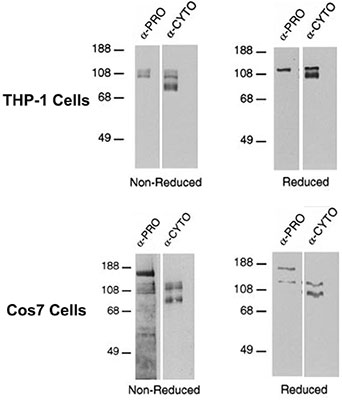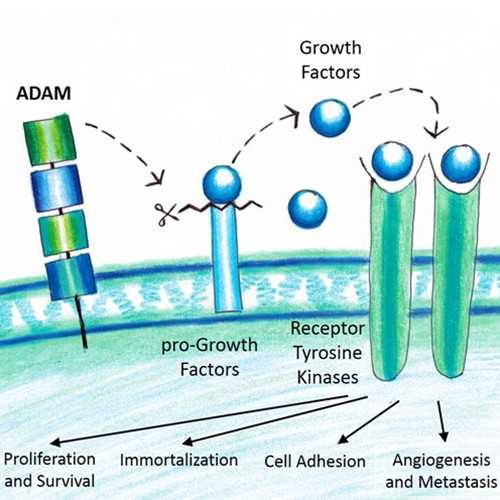Anti-ADAM17 (mouse), Cytoplasmic Domain Antibody
This rabbit IgG polyclonal antibody was generated against the GST-ADAM17-cytoplasmic tail and is specific for the cytoplasmic domain of mouse ADAM17.
The ADAM (A Disintegrin And Metalloprotease Domain) family is a unique group of proteins that has the ability to cleave or shed extracellular portions of transmembrane proteins. In addition, ADAMs are involved in cell-cell and cell-matrix interactions (e.g., fertilization, muscle development and neurogenesis).
ADAM17 (also referred to as Tumor Necrosis Factor Convertase, TACE) is involved in the processing of tumor necrosis factor alpha (TNF-a) at the surface of the cell, and is also required for shedding several ligands of the epidermal growth factor receptor and many other membrane proteins.
From the laboratory of Carl P. Blobel, MD, PhD, Hospital for Special Surgery.
 Part of The Investigator's Annexe program.
Part of The Investigator's Annexe program.
This rabbit IgG polyclonal antibody was generated against the GST-ADAM17-cytoplasmic tail and is specific for the cytoplasmic domain of mouse ADAM17.
The ADAM (A Disintegrin And Metalloprotease Domain) family is a unique group of proteins that has the ability to cleave or shed extracellular portions of transmembrane proteins. In addition, ADAMs are involved in cell-cell and cell-matrix interactions (e.g., fertilization, muscle development and neurogenesis).
ADAM17 (also referred to as Tumor Necrosis Factor Convertase, TACE) is involved in the processing of tumor necrosis factor alpha (TNF-a) at the surface of the cell, and is also required for shedding several ligands of the epidermal growth factor receptor and many other membrane proteins.
From the laboratory of Carl P. Blobel, MD, PhD, Hospital for Special Surgery.
 Part of The Investigator's Annexe program.
Part of The Investigator's Annexe program.
| Product Type: | Antibody |
| Antigen: | GST-ADAM17 Cytoplasmc Domain |
| Accession ID: | P78536 |
| Molecular Weight: | ~100 kDa (mature form), ~120 kDa (pro-form) |
| Isotype: | IgG |
| Clonality: | Polyclonal |
| Reactivity: | Mouse |
| Immunogen: | GST-cyto corresponding to the cytoplasmic domain of mouse ADAM17 |
| Species Immunized: | Rabbit |
| Epitope: | Cytoplasmic domain |
| Purification Method: | Serum, not purified |
| Tested Applications: | WB (1:1000) |
| Storage: | -80C |
| Shipped: | Dry ice |
| Antibody | Species Reactivity | Specificity |
| ADAM9 | Human | Cytoplasmic Domain |
| ADAM9 | Mouse | Cytoplasmic Domain |
| ADAM12 | Mouse | Cytoplasmic Domain |
| ADAM15 | Human | Cytoplasmic Domain |
| ADAM15 | Mouse | Cytoplasmic Domain |
| ADAM15 | Human | Extracellular Domain |
| ADAM15 | Mouse | Disintegrin Domain |
| ADAM17 | Mouse | Cytoplasmic Domain |
| ADAM17 | Mouse | Pro domain |
| ADAM19 | Mouse | Cytoplasmic Domain |
| ADAM28 | Mouse | Cytoplasmic Domain |
| ADAM28 | Mouse | Extracellular Domain |
| SNX9 | Mouse | Cytoplasmic Domain |
Western Blot Analysis

Antibodies against: pro-domain fused to GST (α-PRO), cytoplasmic domain fused to GST (α-CYTO).
Adapted from: Schlöndorff J, et al. JBiochem J. 2000, 347, 131-138.
Cell lysis buffer must contain 5 mM 1,10 Phenanthroline to prevent autodegradation of the mature form of ADAM17, which is not prevented by EDTA or typical protease inhibitor cocktails (Schlöndorff et al., Biochem J. 2000, 347, 131-138).
- Schlöndorff, J.; Becherer, J. D.; Blobel, C. P. Intracellular maturation and localization of the tumour necrosis factor alpha convertase (TACE). Biochem J. 2000, 347, 131-138.
- Zheng, Y.; Schlondorff, J.; Blobel, C. P. Evidence for regulation of the tumor necrosis factor alpha-convertase (TACE) by protein-tyrosine phosphatase PTPH1. J. Biol. Chem. 2002, 277, 42463-42470.
- Horiuchi, K.; Kimura T.; Miyamoto T.; Takaishi H.; Okada Y.; Toyama, Y., Blobel, C. P. Cutting edge: TNF-alpha-converting enzyme (TACE/ADAM17) inactivation in mouse myeloid cells prevents lethality from endotoxin shock. J. Immunol. 2007, 179, 2686-2689.
- Le Gall, S. M., Maretzky, T., Issuree, P. D., Niu, X. D.; Reiss, K., Saftig, P., Khokha, R., Lundell, D., Blobel, C. P. ADAM17 is regulated by a rapid and reversible mechanism that controls access to its catalytic site. J. Cell. Sci. 2010, 123, 3913-3922.
- Maretzky, T., Evers, A., Zhou, W., Swendeman, S. L., Wong, P. M., Rafii, S., Reiss, K., Blobel C. P. Migration of growth factor-stimulated epithelial and endothelial cells depends on EGFR transactivation by ADAM17. Nat. Commun. 2011, 2, 1-25.
- McIlwain DR, Lang PA, Maretzky T, Hamada K, Ohishi K, Maney SK, Berger T, Murthy A, Duncan G, Xu HC, Lang KS, Häussinger D, Wakeham A, Itie-Youten A, Khokha R, Ohashi PS, Blobel CP, Mak TW. iRhom2 regulation of TACE controls TNF-mediated protection against Listeria and responses to LPS. Science. 2012 Jan 13;335(6065):229-32.
If you publish research with this product, please let us know so we can cite your paper.


